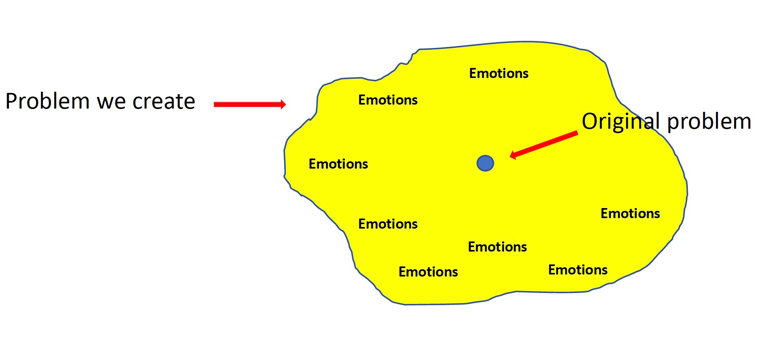Simplifying our Stories

As leaders, we spend a lot of time in our heads speculating about next steps, teasing out possibilities, and getting stuck. Often, we take simple problems, add an unhealthy dose of “what if” to the mix, and create a horrifying view of a future decision or discussion that scares us into inaction.
The problem is rarely the problem. It sits like a small dot on the otherwise blank piece of paper in front of us. The problem arises when we add the complexity of our imaginations and the clouds of emotion that carry our fears of not being enough or of being an imposter in business casual clothes.

Because our genetic wiring guides us to add meaning, assumptions, and beliefs to our simple dots, we must find ways to manage our stories to serve us.
Define
- Write down the problem that you observe, not the one you imagine
- Observe: Cindy missed a deadline.
- Imagine: Cindy missed a deadline because she is chronically disorganized and doesn’t respect the team.
Ask
- Build questions using tentative language that helps you understand the cause of the problem.
- Question: Cindy, you missed the client deadline, can you help me understand what happened?
- Question: Cindy, you said that you communicated with your manager, but he didn’t respond, and you weren’t sure what else to do. Do I have that right?
- Question: Cindy, is there something we can change that will keep this from happening again in the future?
- Question: Cindy, what can I do to support you moving forward?
- Question: Cindy, what are you personally willing to do to make sure we serve our clients at the highest level in the future?
Decide
- Based on the discussion above, determine whether there is a need for an improved process, more coaching, or better training for Cindy, for the team, and for the manager.
- Focus on fixing the problem rather than fixing blame and create higher trust in the team.
Act
- Take decisive action to fix the problem.
- Communicate what you are going to do to make things the way you want them.
- Establish a method of two-way communication that welcomes questions and suggestions from team members. Again, this creates an environment of higher trust.
Takeaway: Taking the time to check our stories and simplify the problem serves us. It allows us to effectively find the root cause of a problem, hold the discussions required to help us decide the best path, and to act in a way that solves the problem and enhances team trust. And a team with high trust is one that delivers consistently high performance.